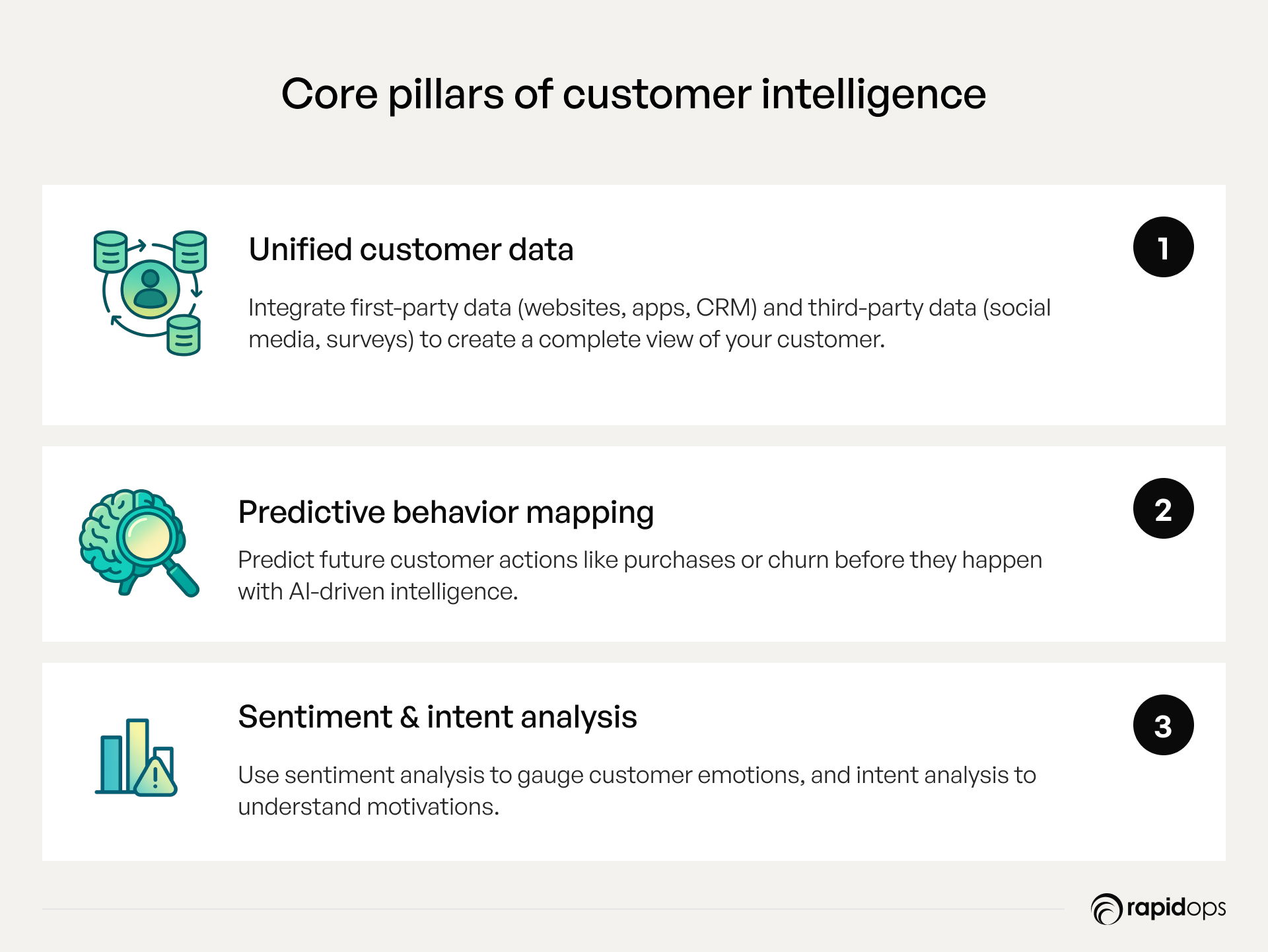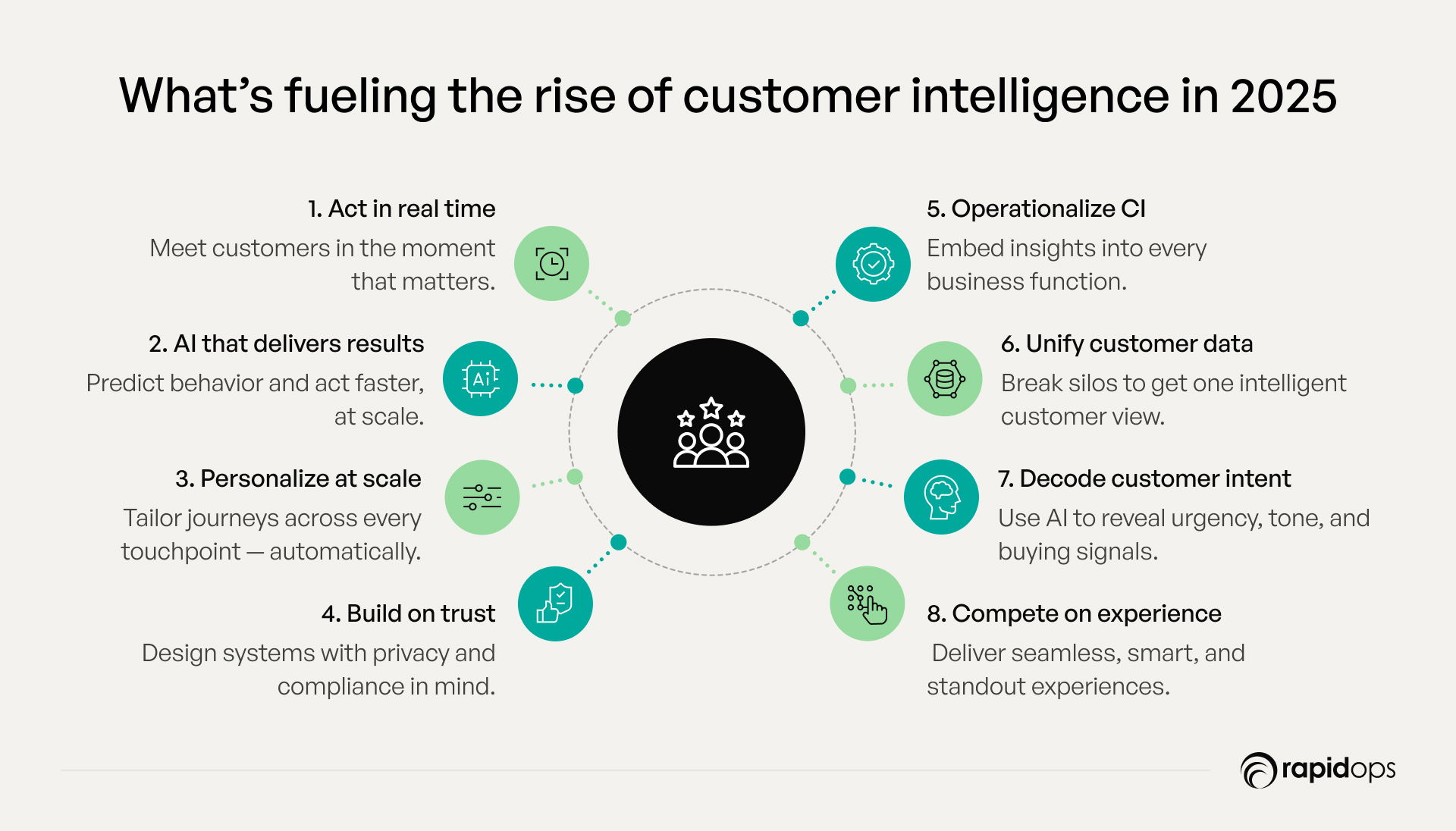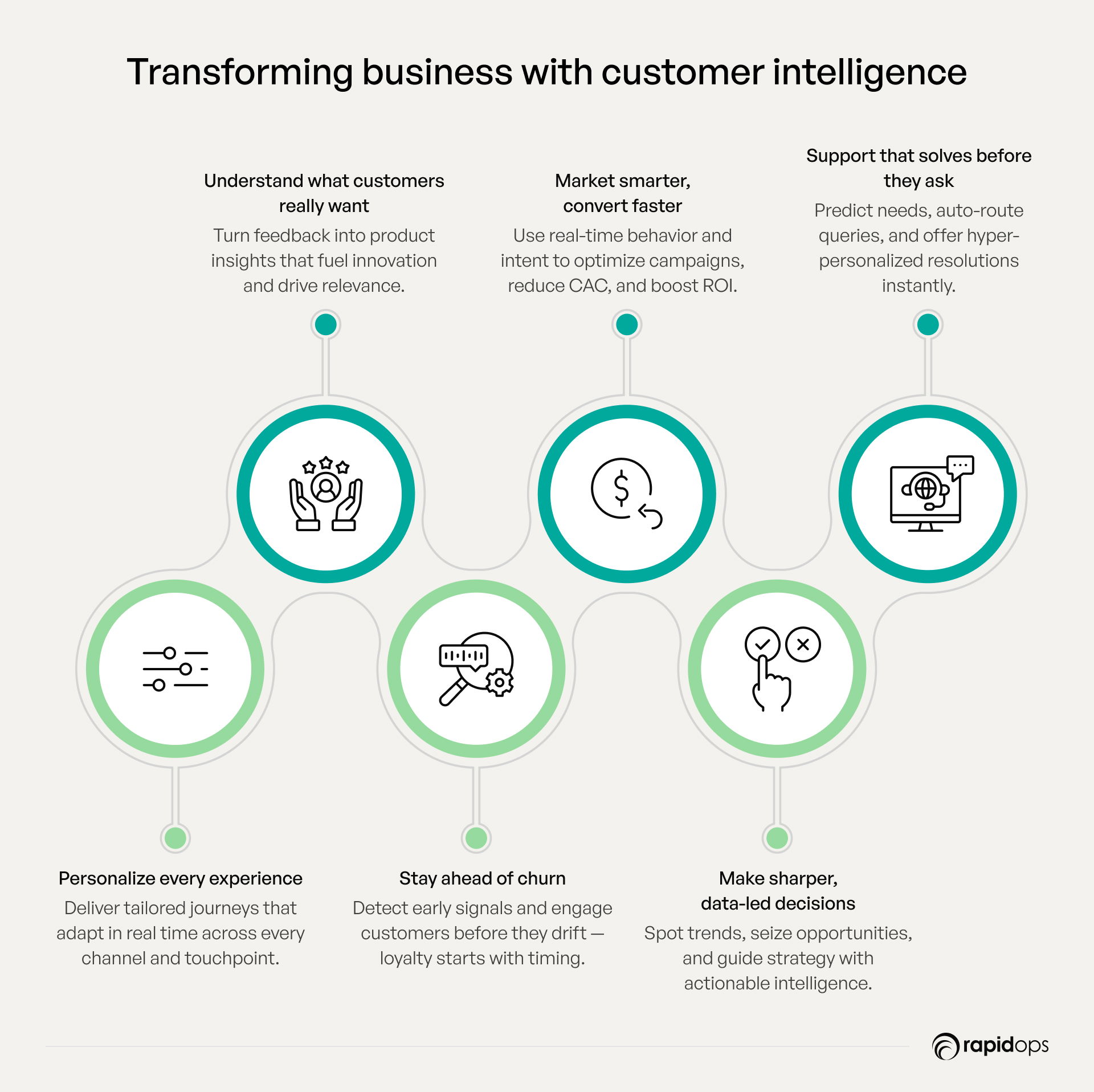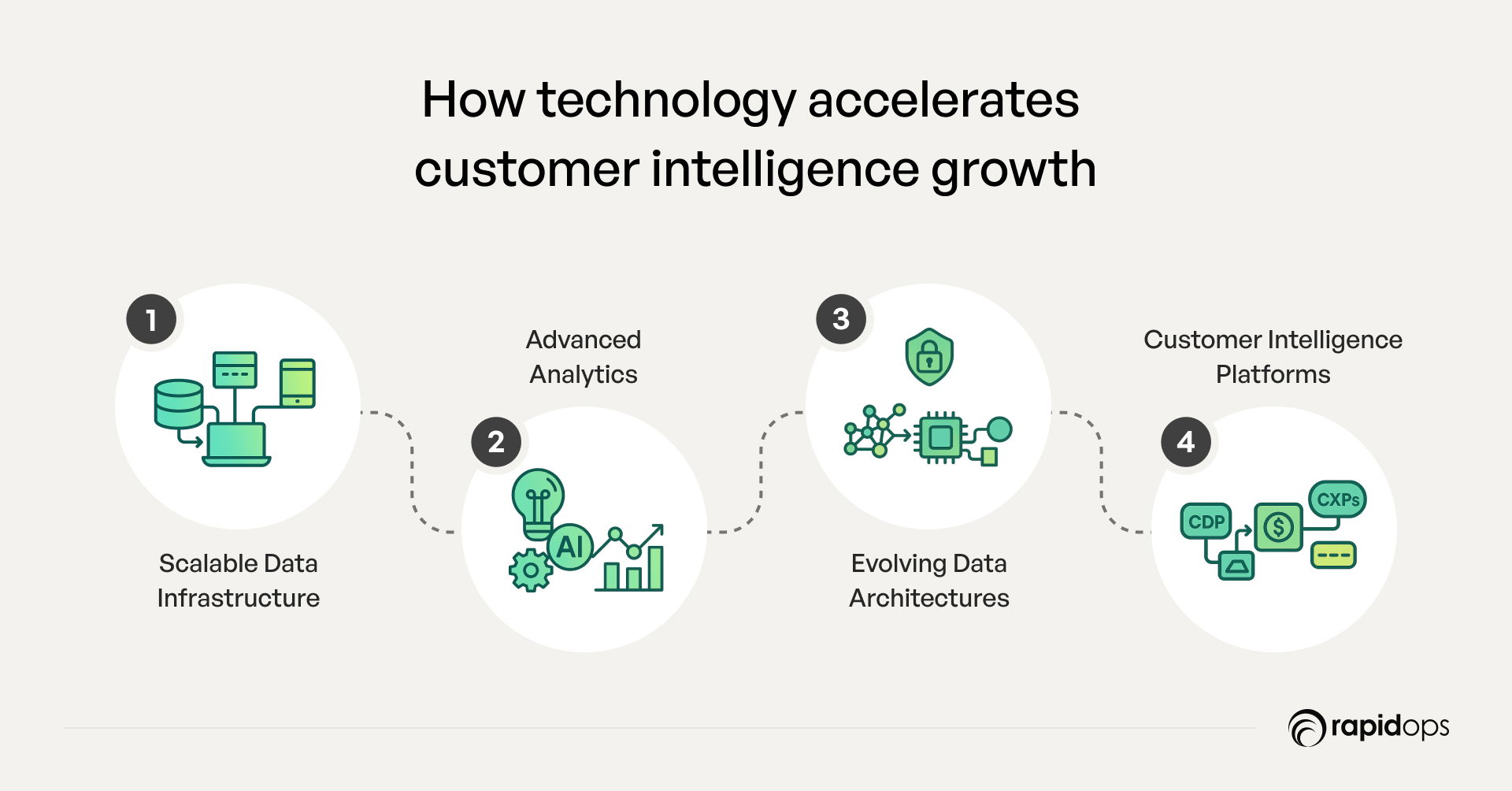2025 is not just another year of digital acceleration, it’s a turning point in how businesses understand, engage, and serve their customers. As markets grow more saturated and customer expectations shift faster than ever, traditional approaches to customer understanding are falling short. Surface-level insights, static personas, and rearview analytics no longer suffice.
What’s changing the game? Customer intelligence.
Fueled by real-time data, AI, and advanced analytics, customer intelligence is enabling businesses to move beyond assumptions and act on precision. It’s not just helping brands understand who their customers are, it’s revealing why they behave the way they do and what they’ll expect next.
Whether you're in retail, manufacturing or tech, leveraging customer intelligence is no longer optional, it’s foundational to growth, innovation, and competitive edge in 2025.
In this article, we’ll explore how customer intelligence is transforming the way businesses operate, the strategic technologies and infrastructures enabling it, and the new business models and industry dynamics it’s helping shape, all with a sharp focus on the opportunities that lie ahead.
Understanding customer intelligence: Its impact and functionality
In 2025, meeting customer expectations requires more than data, it demands intelligence. Customer intelligence goes beyond numbers to deliver deep, actionable insights that help businesses truly understand their customers, anticipate needs, and respond with precision. Here's what it really means, how it's different, and why it matters now more than ever.
What is customer intelligence?
Customer intelligence is the systematic process of gathering, analyzing, and leveraging real-time, multidimensional customer data to generate actionable insights. Unlike traditional analytics, customer intelligence integrates behavioral, transactional, and demographic data, creating a unified, 360-degree view of each customer.
This allows businesses to predict customer needs, personalize experiences, and optimize engagement strategies, leading to more informed, data-driven decision-making.
As businesses face increasing pressure to stay agile and competitive, customer intellligence enables leaders to make proactive decisions by uncovering trends and anticipating shifts in consumer behavior. It’s no longer just about collecting data, it's about transforming that data into strategic actions that drive growth, enhance loyalty, and improve customer lifetime value.
In 2025, customer intelligence is a critical enabler for organizations looking to thrive in an era of hyper-personalization, where customer expectations are at an all-time high.
How is it different from customer data, analytics and intelligence?
As businesses pursue customer-centric growth, distinguishing between data, analytics, and intelligence is key to transforming raw information into strategic foresight at scale.
Customer data: Essential, but inert
Customer data represents raw, unprocessed information generated through interactions, transactions, web activity, and service engagements. While essential, it is inherently passive and offers no actionable insights on its own.
- Value proposition: Provides a factual record of who the customer is, what they did, and when.
- Limitation: Lacks context or the ability to reveal intent, emotion, or future behavior. Without analysis, it cannot inform strategy.
Customer analytics: Retrospective insight
Customer analytics applies structure to data through segmentation, clustering, and trend analysis. It helps organizations understand what happened, and to whom.
- Value proposition: Identifies historical trends and behavioral segments, offering insights into past customer actions.
- Limitation: Primarily descriptive, explaining the past with limited ability to predict future actions, making it reactive rather than proactive.
Customer intelligence: From insight to impact
Customer intelligence takes analytics a step further, combining data, analytics, machine learning, and real-time modeling to shift from analysis to actionable insights.
- Value proposition: Anticipates future customer behavior (e.g., churn, propensity to buy) and provides prescriptive guidance on how to engage.
- Dynamic at scale: Continuously adapts as it learns from new data, enabling context-aware, personalized engagement across the organization.
- Limitation: While powerful, customer intelligence depends heavily on data quality, integration across systems, and organizational readiness. Without these foundations, its full potential remains untapped.
Customer data tells you what happened. Customer analytics tells you why it happened. Customer intelligence tells you what to do next, and enables you to do it at scale
Key components of customer intelligence
Customer intelligence empowers organizations to make proactive, data-driven decisions that significantly enhance customer experiences and business outcomes. It shifts businesses from traditional, reactive analytics to real-time insights that drive strategic action. Here are the critical elements that enable customer intelligence to deliver these powerful results.

1. Unified customer data
To build a successful customer intelligence strategy, businesses must first integrate data from a variety of sources.
This includes both first-party data, such as interactions from websites, mobile apps, and CRM systems, and third-party data from external platforms like social media, surveys, or market research.
The integration of these different data sets creates a unified view of the customer, providing a comprehensive understanding of their behaviors, preferences, and engagement patterns.
2. Predictive behavior mapping
One of the most valuable aspects of customer intelligence is its ability to predict future customer actions.
Through predictive behavior mapping, businesses can anticipate behaviors such as purchases, cart abandonment, or churn.
By understanding these potential actions in advance, companies can take proactive measures to engage customers, prevent churn, and increase retention, ultimately leading to more satisfied and loyal customers.
3. Sentiment and intent analysis
In addition to understanding what customers do, customer intelligence helps businesses understand why they do it.
Sentiment analysis uses natural language processing (NLP) to evaluate feedback, such as reviews or social media interactions, to gauge customer emotions and satisfaction.
Meanwhile, intent analysis digs deeper into the motivations behind a customer’s actions, providing insight into their goals and needs. Together, these analyses enable businesses to offer timely, relevant, and personalized interventions that enhance customer satisfaction and loyalty.
How customer intelligence works
Customer intelligence is not a one-time effort but a dynamic, ongoing process that transforms raw data into actionable insights. By harnessing the power of continuous feedback loops, businesses can drive real-time decisions, elevate customer experience, and optimize their strategies over time.
Below is a breakdown of how customer intelligence works in a simplified, yet deeply impactful manner.

Capturing every customer touchpoint
The foundation of customer intelligence lies in capturing data from every customer interaction, whether it’s online, in-store, through customer service, or via sales.
This step ensures that every detail about a customer's journey is logged, from initial browsing to post-purchase feedback.
Every touchpoint is an opportunity to gather valuable insights that reflect a customer’s needs, behaviors, and intentions.
Organizing the data
Once data is captured, it must be organized in a structured way.
This typically happens within platforms like customer relationship management (CRM) systems, customer data platforms (CDPs), or data lakes.
These systems serve as centralized repositories that enable businesses to maintain a cohesive, 360-degree view of each customer.
By bringing together data from multiple sources, such as website interactions, transaction history, and customer service logs, businesses can ensure they are working with the most complete and accurate data available.
Analyzing data with AI-driven models
The true power of customer intelligence comes from analyzing the data using advanced AI and machine learning models.
These models go beyond simple reporting, identifying hidden patterns, trends, and relationships within the data.
AI algorithms predict future behaviors, such as which customers are likely to churn, which products they may be interested in, or how likely they are to engage with a specific offer.
This predictive power allows businesses to make proactive, informed decisions.
Activating insights across channels
Finally, the insights derived from customer Intelligence are used to activate personalized strategies across all customer-facing touchpoints. This might involve tailoring content, sending personalized offers, recommending products based on past behavior, or guiding a customer through a more intuitive support process.
The goal is to ensure that every interaction is not just informed but also strategically aligned to meet the customer’s needs at that specific moment, providing a seamless, individualized experience across all channels.
By continuously looping through these steps capture, organize, analyze, and activate. Customer intelligence enables businesses to build deeper, more meaningful relationships with their customers. This not only helps improve customer satisfaction but also drives long-term growth and loyalty.
The forces fueling the rise of customer intelligence in 2025
Customer intelligence has moved from a strategic advantage to a business imperative in 2025. Its rise is driven by a convergence of technological, behavioral, and competitive forces, each shaping how organizations gather, interpret, and act on customer data. Below are the core drivers accelerating this shift.

1. Surge in real-time customer interactions across digital touchpoints
Digital engagement has become a continuous, non-linear journey, spanning mobile apps, websites, smart devices, social platforms, and even voice interfaces. Customers interact across these channels expecting frictionless experiences and rapid responses.
This behavioral shift has compelled businesses to evolve from static data analysis to dynamic intelligence systems that process and react to customer signals as they happen. Customer intelligence empowers organizations to orchestrate real-time responses, whether it’s adapting content, offering support, or delivering a product recommendation, at the exact moment of need.
2. Maturity of AI and advanced analytics
What was once aspirational is now operational. AI, ML, and advanced analytics technologies have matured to the point where they can handle enormous data volumes with speed and precision. In 2025, leading organizations are leveraging these tools not just for reporting, but for real-time prediction, customer segmentation, lifecycle scoring, and next-best-action modeling.
The accessibility of these capabilities, through cloud platforms and composable data architectures, has lowered the barrier to entry, making sophisticated customer intelligence achievable even beyond Fortune 500 enterprises.
3. Rising demand for hyper-personalized, frictionless experiences
Customers expect businesses to know who they are, what they need, and how they want to be served, without having to repeat themselves across channels. Generic experiences are now considered a failure in customer-centricity.
Customer intelligence enables brands to move beyond segmentation into individualization, adapting every touchpoint, marketing, sales, service, and product, to the context and behavior of each customer in real time. This not only boosts satisfaction and loyalty, but also drives measurable ROI across acquisition, conversion, and retention.
4. Evolution of data privacy, ethics, and governance
The rise of customer intelligence hasn’t occurred in a vacuum. Regulatory landscapes such as GDPR, CCPA, and emerging global data protection laws have raised the stakes for responsible data use. At the same time, customers are becoming more selective about whom they trust with their data.
In response, organizations are embedding privacy-by-design, zero-party data strategies, and consent-first practices into their customer intelligence frameworks. These ethical guardrails don’t limit innovation, they enable sustainable intelligence that enhances both compliance and customer trust.
5. Shift from experimentation to full-scale operationalization
In past years, customer intelligence often lived in siloed pilots or analytics teams. In 2025, it’s becoming embedded across the enterprise, from marketing and commerce to product development and customer support.
Companies are investing in centralized intelligence layers, customer data platforms (CDPs), and cross-functional teams that make a core operating system, not a one-off initiative. This shift reflects a new maturity, customer intelligence isn’t just a tool, it’s a strategic discipline shaping decisions at every level.
6. Omnichannel data integration for a unified customer view
Fragmentation is the enemy of intelligence. Today’s businesses must integrate data from CRM, POS systems, IoT devices, customer service logs, loyalty programs, and digital platforms to form a single source of truth.
The rise of data fabric and composable data ecosystems makes it possible to unify and activate this information across all touchpoints. Customer intelligence thrives in this environment, turning disconnected signals into cohesive customer stories that drive smarter engagement.
7. Progress in natural language processing (NLP) and sentiment analysis
Advanced NLP models now interpret not just keywords, but emotion, nuance, and behavioral cues across text, voice, and video. Sentiment and intent can be inferred from unstructured feedback at scale from support chats and surveys to social media posts and call transcripts.
This depth of insight gives organizations the emotional intelligence needed to adapt tone, messaging, and strategy in real time, bridging the gap between what customers say and what they actually mean.
8. Intensifying market competition and experience-led differentiation
As markets saturate and product offerings become increasingly similar, customer experience is emerging as the new battleground. Businesses are competing on how well they understand, anticipate, and serve their customers.
Customer intelligence becomes the engine behind this competitive edge, fueling agile decision-making, real-time personalization, and smarter customer journey design. In 2025, the organizations that master CI aren’t just meeting expectations, they’re setting new standards.
How customer intelligence is empowering businesses today
In 2025, customer intelligence isn’t just helpful, it’s essential. It gives businesses the power to anticipate customer needs before they surface, turning raw data into timely, personalized experiences. By acting on real-time insights, companies are no longer just responding to behavior, they’re shaping it. This foresight fuels smarter decisions, deeper relationships, and lasting growth.
Let’s explore how customer intelligence is driving impact across key business areas.

1. Driving hyper-personalization at scale
With customer intelligence, businesses can achieve hyper-personalization across digital and physical touchpoints, tailored to individual customer needs, behaviors, and preferences. By using real-time data to segment customers dynamically, businesses can deliver highly personalized experiences that evolve with customer interactions.
This creates deeper connections with customers, improving engagement and fostering loyalty. For example, a retailer could personalize product recommendations on their website based on past browsing behavior, while also offering personalized promotions in-store through mobile apps.
2. Transforming product innovation and development
Customer intelligence empowers companies to move beyond traditional methods of product development by turning unstructured feedback (reviews, surveys, social media comments) into actionable insights.
By analyzing this feedback, businesses can anticipate market needs and quickly adapt their product offerings. Predictive modeling, driven by customer sentiment and behavior, allows businesses to forecast trends before they emerge.
Moreover, insight-driven feedback loops enable customers to actively participate in the product creation process, fostering innovation and ensuring products resonate with the market.
3. Boosting customer retention and lifetime value
Customer intelligence plays a crucial role in retaining customers and maximizing lifetime value. By identifying early churn signals, businesses can proactively intervene to prevent customer attrition.
Using predictive analytics, companies can create adaptive loyalty programs that evolve with changing customer behavior, ensuring they remain relevant and engaging over time. This approach helps businesses not only retain customers but also deepen their relationships by delivering the right value at the right time.
4. Optimizing sales and marketing ROI
Customer intelligence dramatically enhances marketing efforts by providing enriched customer profiles that allow for precise targeting and personalized content delivery. With the ability to make real-time adjustments based on intent and engagement signals, businesses can optimize their campaigns for better ROI.
By identifying the right prospects and serving them content tailored to their needs and preferences, businesses lower acquisition costs and boost conversion rates. This intelligence-driven approach leads to more effective sales funnels, driving both efficiency and results.
5. Empowering strategic decision-making across the business
At the strategic level, customer intelligence informs key business decisions with data-driven insights that highlight emerging trends, market opportunities, and customer demands.
By leveraging customer-centric data models, businesses can forecast future growth areas, identify white space opportunities, and prioritize investments that will deliver the greatest impact.
These insights not only guide day-to-day operations but also help executive teams make informed, long-term decisions about product lines, markets, and investments.
6. Enhancing customer support and service experiences
Customer intelligence is revolutionizing customer support by enabling businesses to predict and resolve issues before they escalate. By using intent-based routing powered by AI and unified customer profiles, businesses can route inquiries to the right agents, reducing friction and improving resolution times.
Moreover, personalized support becomes possible by leveraging comprehensive customer data, allowing support teams to offer tailored solutions quickly and efficiently. This proactive, personalized approach transforms the customer service experience, ensuring issues are resolved in a timely and effective manner.
The role of technology in scaling customer intelligence
In 2025, as businesses continue to prioritize customer intelligence to drive exceptional, personalized experiences, robust data infrastructure and advanced technologies are essential for scaling customer intelligence efforts. Here's how these components play a crucial role in leveraging data for more insightful, actionable, and real-time customer interactions.

1. Building a scalable data infrastructure for customer intelligence
A robust data infrastructure for customer intelligence requires a strategic approach to centralize and integrate data from various touchpoints, such as CRM systems, social media, websites, and transactional platforms.
This integration creates a comprehensive, real-time customer profile, providing a foundation for accurate, data-driven decision-making. Selecting the right storage solution is pivotal: data lakes are ideal for unstructured data, like social media content and logs, offering flexibility and scalability.
On the other hand, data warehouses efficiently store and analyze structured data, enabling deeper insights. Understanding how and when to use each ensures businesses can effectively scale their customer intelligence strategy and unlock greater value.
2. Leveraging advanced analytics for actionable customer insights
Advanced analytics, powered by machine learning, enables businesses to transform data into strategic insights. Predictive analytics forecasts customer behavior, such as purchase intent or churn risks, allowing businesses to take proactive measures.
Prescriptive analytics builds on this by recommending specific actions to optimize results, fostering personalized experiences and increasing customer loyalty. AI-driven customer segmentation refines profiles in real-time, enabling tailored interactions based on evolving behavior and preferences.
Meanwhile, natural language processing (NLP) analyzes unstructured data, like reviews and social media, revealing customer sentiment and pain points to inform targeted marketing and product strategies.
3. Data governance, privacy, and compliance in scaling customer intelligence
Scaling customer intelligence relies on accurate, consistent data. A robust data governance framework enforces policies for validation, cleansing, and stewardship, eliminating duplicates, outdated entries, and inconsistencies. This ensures insights are drawn from reliable data, supporting better decisions and more precise customer understanding.
As regulations like GDPR and CCPA evolve, maintaining compliance is non-negotiable. Scalable CI systems embed privacy by design, managing consent, monitoring data use, and enforcing region-specific controls. This not only reduces risk but also builds customer trust through transparent and ethical data handling.
4. The role of customer intelligence platforms in scaling insights
Customer data platforms (CDPs)
Customer data platforms (CDPs) are vital in providing a unified, 360-degree view of the customer.
By integrating data from multiple sources, CDPs create detailed, actionable customer profiles that can be leveraged across marketing, sales, and customer service teams.
With a centralized view of customer behavior and preferences, businesses can deliver highly targeted and personalized experiences, driving customer satisfaction and loyalty.
Customer experience platforms
Customer experience platforms enable businesses to integrate various tools and systems for delivering seamless, consistent, and personalized customer interactions.
By connecting data from different channels, whether in-store, online, or over-the-phone CX platforms ensure that every touchpoint provides a cohesive experience.
This integration fosters stronger customer relationships, improved engagement, and enhanced brand loyalty.
AI-powered analytics solutions
AI-powered analytics platforms are instrumental in scaling customer intelligence by providing deep, real-time insights into customer behavior.
These solutions continuously learn from customer interactions, refining strategies to drive even more effective personalized experiences.
By incorporating AI into CI platforms, businesses can accelerate their data-driven decision-making processes, optimizing customer interactions and strategies at every stage of the customer journey.
5. Evolving data architectures to support future growth
As the volume of customer data grows, businesses are increasingly adopting edge computing to enable real-time data processing closer to the source of data generation.
This technology reduces latency and enhances the responsiveness of customer interactions, making it ideal for applications like IoT devices, real-time customer service, and location-based services.
Blockchain technology is gaining traction for its ability to ensure data security and transparency in customer interactions. By providing a decentralized ledger for customer data, blockchain enables secure transactions and guarantees the integrity of customer information. This can increase customer trust, particularly in industries where data privacy and security are paramount.
For businesses to scale their customer intelligence capabilities efficiently, they need flexible, adaptable systems. Scalable APIs and microservices enable businesses to integrate new tools, data sources, and customer engagement channels seamlessly.
This modular approach ensures that businesses can continuously evolve their customer intelligence strategy without being tied to legacy systems, supporting long-term growth and innovation.
Customer intelligence in action: Real-world use cases
Customer intelligence is reshaping how businesses connect with customers. Stitch Fix shows how strategic CI can fuel personalization at scale, enhance loyalty, and optimize operations, all by turning data into actionable insight.
Stitch Fix: Personalizing at scale with data-driven insights
Stitch Fix has redefined personalization in the retail space by embedding data at the core of its business model.
What sets Stitch Fix apart is its ability to not only use data to recommend products, but to continuously refine every touchpoint of the customer journey based on evolving preferences and behaviors.
The company blends various customer inputs, from style surveys and purchase history to browsing patterns and real-time feedback, to create dynamic, up-to-date customer profiles that improve over time.
This ongoing data flow fuels Stitch Fix's recommendations, which aren’t just automated one-size-fits-all solutions, but personalized, scalable suggestions that meet the unique needs of each shopper.
By combining machine learning algorithms with human stylists' expertise, Stitch Fix ensures that every recommendation is both data-informed and contextually relevant, giving customers a seamless shopping experience.
Through this approach, Stitch Fix has achieved significant results:
- Reduced return rates: By understanding customer preferences more precisely.
- Increased retention and lifetime value: By creating a shopping experience that feels tailor-made.
- Optimized inventory and marketing: By aligning product selections with customer demand and preferences.
This is a clear example of how customer intelligence doesn’t just help businesses react to customer needs, it empowers them to anticipate and adapt to those needs at a scale, creating a deeply personalized and engaging experience.
From insight to intelligence: A thoughtful path forward
As we approach 2025, businesses that will stand out are those who not only collect data but understand and apply it to drive meaningful decisions. Customer intelligence is about translating data into actionable insights, enabling businesses to adapt to their customers’ needs when they matter most.
Every organization is at a different stage on this journey. Some may be beginning to explore their data, while others are refining how they integrate intelligence across every customer touchpoint. No matter where you are, the real value lies in understanding where improvements can be made and how deeper insights can enhance your strategy.
At Rapidops, we work alongside businesses at all stages, whether you’re just starting to explore customer intelligence or refining an established strategy. What we’ve found is that true progress begins with the right questions, focusing on how customer intelligence can drive tangible value.
If you’re curious about how customer intelligence analytics could benefit your business or wondering how to leverage it effectively, we’re here to help. Schedule a free consultation with our expert to explore how these insights can enhance your business strategy and drive meaningful growth.

Rahul Chaudhary
Content Writer
With 5 years of experience in AI, software, and digital transformation, I’m passionate about making complex concepts easy to understand and apply. I create content that speaks to business leaders, offering practical, data-driven solutions that help you tackle real challenges and make informed decisions that drive growth.
What’s Inside
- Understanding customer intelligence: Its impact and functionality
- The forces fueling the rise of customer intelligence in 2025
- How customer intelligence is empowering businesses today
- The role of technology in scaling customer intelligence
- Customer intelligence in action: Real-world use cases
- From insight to intelligence: A thoughtful path forward

Let’s build the next big thing!
Share your ideas and vision with us to explore your digital opportunities
Similar Stories
- Transformation
- undefined Mins
- March 2022

- Transformation
- undefined Mins
- March 2020


Receive articles like this in your mailbox
Sign up to get weekly insights & inspiration in your inbox.

